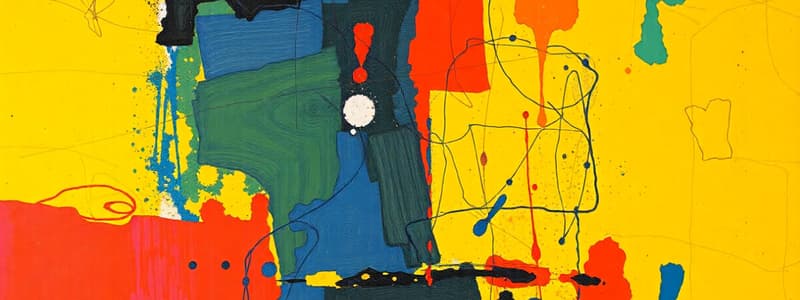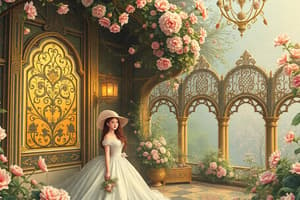Podcast
Questions and Answers
Which of the following is NOT considered a category of arts?
Which of the following is NOT considered a category of arts?
- Visual Arts
- Culinary Arts (correct)
- Literary Arts
- Performing Arts
What is a key feature of the Performing Arts?
What is a key feature of the Performing Arts?
- Explores themes and narratives through written text
- Involves live performance in front of an audience (correct)
- Utilizes various digital media for creation
- Focus on aesthetics and visual perception
Which art movement is characterized by a focus on emotion over reason?
Which art movement is characterized by a focus on emotion over reason?
- Renaissance
- Baroque
- Romanticism (correct)
- Modernism
What function does the arts serve in promoting critical thinking?
What function does the arts serve in promoting critical thinking?
Which artist is renowned for co-founding Cubism?
Which artist is renowned for co-founding Cubism?
Which of the following mediums is NOT typically associated with sculpture?
Which of the following mediums is NOT typically associated with sculpture?
What current trend in the arts emphasizes inclusivity and community involvement?
What current trend in the arts emphasizes inclusivity and community involvement?
Which aspect of the arts is most likely to enhance mental health and well-being?
Which aspect of the arts is most likely to enhance mental health and well-being?
Flashcards are hidden until you start studying
Study Notes
Definition of Arts
- Encompasses diverse creative expressions.
- Includes visual arts, performing arts, literature, music, and more.
Categories of Arts
-
Visual Arts
- Painting, sculpture, photography, and installation art.
- Focuses on aesthetics and visual perception.
-
Performing Arts
- Theater, dance, music, and opera.
- Involves live performance in front of an audience.
-
Literary Arts
- Poetry, novels, essays, and plays.
- Explores themes, narratives, and human experiences.
-
Music
- Includes various genres (classical, jazz, rock, etc.).
- Composed of melody, harmony, rhythm, and lyrics.
-
Applied Arts
- Design fields like graphic design, fashion design, and architecture.
- Merges aesthetics with utility.
Functions of Arts
- Expression: Communicates emotions and ideas.
- Cultural Reflection: Represents societal values and beliefs.
- Education: Promotes critical thinking and creative problem-solving.
- Entertainment: Provides enjoyment and leisure activities.
Art Movements
- Renaissance: Humanism, realism, classical themes.
- Baroque: Drama, rich colors, and intense light.
- Romanticism: Emotion over reason, nature, and individualism.
- Modernism: Abstract art, experimentation, and breaking traditions.
- Postmodernism: Questioning established narratives, diverse perspectives.
Key Artists and Their Contributions
- Leonardo da Vinci: Master of the Renaissance, known for "Mona Lisa" and "The Last Supper."
- Pablo Picasso: Co-founder of Cubism, groundbreaking paintings like "Guernica."
- William Shakespeare: Influential playwright and poet, explored human nature and society.
Techniques and Mediums
- Painting: Acrylic, oil, watercolor, and mixed media.
- Sculpture: Carving, modeling, casting, and assembling in various materials.
- Photography: Digital and film photography, focuses on composition and lighting.
- Theatre: Scriptwriting, acting, directing, and stage design.
Importance of Arts
- Fosters creativity and innovation.
- Encourages empathy by connecting with diverse experiences.
- Enhances mental health and well-being.
- Promotes social change and awareness.
Current Trends in Arts
- Digital and multimedia art are gaining prominence.
- Increased focus on community art projects and inclusivity.
- Use of technology (VR, AR) in creating and experiencing art.
Definition of Arts
- Arts encompass a wide range of creative expressions, including visual arts, performing arts, literature, music, and more.
Categories of Arts
- Visual Arts focus on aesthetics and visual perception, including painting, sculpture, photography, and installation art.
- Performing Arts involve live performances in front of an audience, encompassing theater, dance, music, and opera.
- Literary Arts explore themes, narratives, and human experiences through poetry, novels, essays, and plays.
- Music is composed of melody, harmony, rhythm, and lyrics, and includes various genres like classical, jazz, and rock.
- Applied Arts merge aesthetics with utility, encompassing design fields such as graphic design, fashion design, and architecture.
Functions of Arts
- Expression: Arts communicate emotions and ideas.
- Cultural Reflection: Arts represent societal values and beliefs.
- Education: Arts promote critical thinking and creative problem-solving.
- Entertainment: Arts provide enjoyment and leisure activities.
Art Movements
- Renaissance: Emphasized humanism, realism, and classical themes.
- Baroque: Characterized by drama, rich colors, and intense light.
- Romanticism: Prioritized emotion over reason, nature, and individualism.
- Modernism: Embraced abstract art, experimentation, and breaking traditions.
- Postmodernism: Questioned established narratives and embraced diverse perspectives.
Key Artists and Their Contributions
- Leonardo da Vinci was a master of the Renaissance, known for his works "Mona Lisa" and "The Last Supper."
- Pablo Picasso co-founded Cubism and created groundbreaking paintings like "Guernica."
- William Shakespeare was an influential playwright and poet who explored human nature and society in his works.
Techniques and Mediums
- Painting: Uses acrylics, oils, watercolor, or mixed media.
- Sculpture: Created by carving, modeling, casting, and assembling materials.
- Photography: Digital and film photography focus on composition and lighting.
- Theatre: Involves scriptwriting, acting, directing, and stage design.
Importance of Arts
- Arts foster creativity and innovation.
- Arts encourage empathy by connecting people with diverse experiences.
- Arts enhance mental health and well-being.
- Arts promote social change and awareness.
Current Trends in Arts
- Digital and multimedia art are gaining prominence.
- There is increased focus on community art projects and inclusivity.
- Technology like VR and AR is increasingly used to create and experience art.
Studying That Suits You
Use AI to generate personalized quizzes and flashcards to suit your learning preferences.




